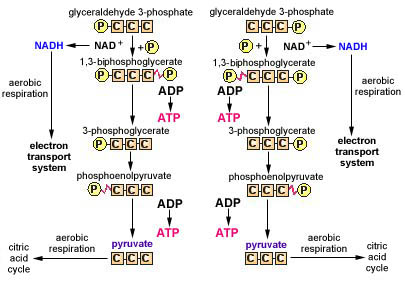
4. Oxidation and phosphorylation
of each glyceraldehyde 3-phosphate produces 1,3-biphosphoglycerate with a high-energy
phosphate bond (wavy red line) and NADH.
5. Through substrate-level phosphorylation, the high-energy phosphate is removed
from each 1,3-biphosphoglycerate and transferred to ADP forming ATP and 3-phosphoglycerate.
6. Each 3-phosphoglycerate is oxidized to form a molecule of phosphoenolpyruvate
with a high-energy phosphate bond.
7. Through substrate-level phosphorylation, the high-energy phosphate is removed
from each phosphoenolpyruvate and transferred to ADP forming ATP and pyruvate.
In summary, one molecule of glucose produces two net ATPs (two ATPs were used at the beginning; four ATPs were produced through substrate-level phosphorylation), two molecules of NADH + 2H+, and two molecules of pyruvate.
During aerobic respiration,
the two pyruvates enter the transition reaction (see
Fig. 13) to produce two NADH, two CO2, and
two molecules of acetyl-CoA. The two acetyl-CoA then enter the citric acid
cycle (see Fig. 17) to be further broken down. During
the transition reaction and the citric acid cycle, the molecules of NADH and FADH2
produced provide hydrogen ions and electrons to the electron transport system
for chemiosmotic phosphorylation (see Fig. 28) and further
ATP production.
During fermentation, the pyruvates
are converted to some fermentation end product (such as lactate or alcohol and
carbon dioxide) without further ATP production.